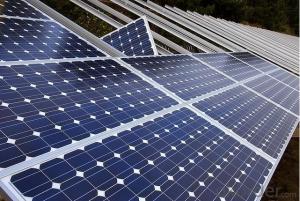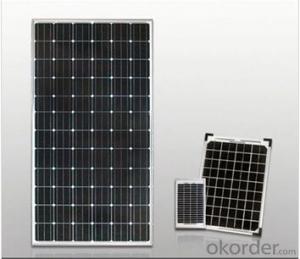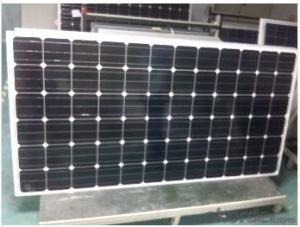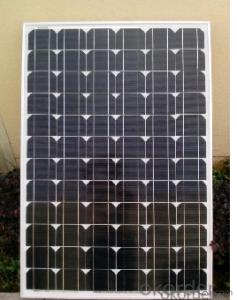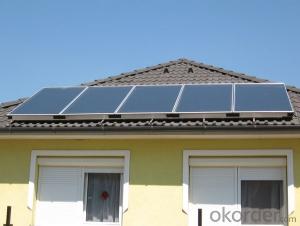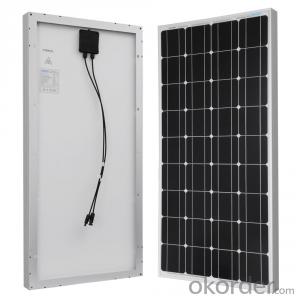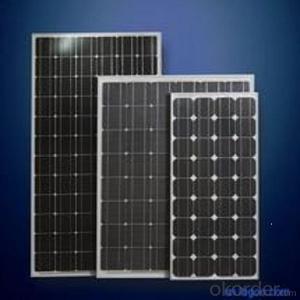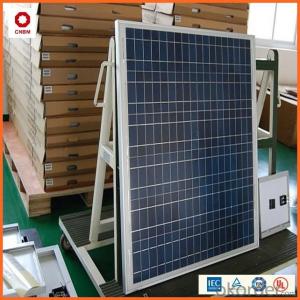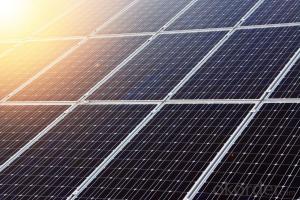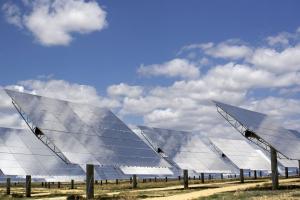In Roof Solar Panels:Solar Panel Solar Module PV Solar with UL TUV Certificates 260W
- Loading Port:
- Shanghai
- Payment Terms:
- TT OR LC
- Min Order Qty:
- 1 watt
- Supply Capability:
- 10000000 watt/month
OKorder Service Pledge
OKorder Financial Service
You Might Also Like
Specification
Solar panel material
1. glass
Its main role is to protect the power generation ( solar cells ) , there is a selection of light transmittance requirements : 1 ) must be high transmittance (typically 91% or more ) ; 2 ) super white steel processing.
2. EVA
For bonding glass and power generation fixed body ( such as cells ) , transparent EVA material directly affect the life of components exposed to the air EVA prone aging yellow , thus affecting the transmittance components , thus affecting in addition to generating the quality of the components itself, the quality EVA lamination process on the component manufacturers is also very large, such as EVA plastic viscosity of non-compliance , EVA and glass, back bonding strength is not enough, can cause premature aging EVA, the affected component life.
3. Solar cells
The main role is to generate electricity , the electricity is the main market mainstream film crystalline silicon solar cells , thin-film solar cells , both have their advantages and disadvantages . Crystalline silicon solar cells , the equipment costs are relatively low , but the high cost of consumption and cells , photoelectric conversion efficiency is high, the next generation in outdoor sunlight is more appropriate ; higher thin-film solar cells , the relative cost of equipment , but the cost of consumption and battery low, relatively low photoelectric conversion efficiency of crystalline silicon solar cells , but the effect is very good low-light , in the ordinary light can also generate electricity , such as solar calculator .
4. backplane
Sealing, insulation , water ( usually with TPT, TPE , etc. ) the material must be resistant to aging , component manufacturers generally have warranty for 25 years , tempered glass, aluminum is generally no problem , the key lies in whether the backplane and can meet the requirements of silica gel.
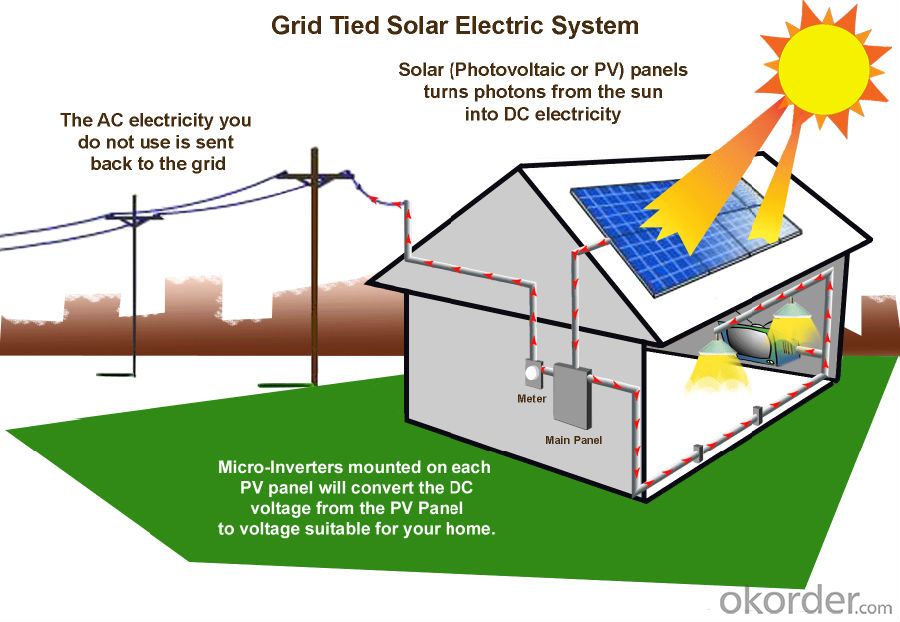
PERFORMANCE
- High effi ciency, multicrystalline silicon solar cells with high transmission and textured glass deliver a module effi ciency of up to 16.0%,
minimizing installation costs and maximizing the kWh output of your system per unit area.
- Tight positive power tolerance of 0W to +5W ensures you receive modules at or above nameplate power and contributes to minimizing
module mismatch losses leading to improved system yield.
Structure of Polycrystalline Silicon Solar Panel Type
Solar modules, which are widely used in ground mounted utility-scale PV plants, large-scale and small civil and commercial power generating system such as BIPV combined to the grid, roof-mounted PV power system, rural electrification, communications, emergency auxiliary power.
Solar PV module is comprised of some solar cells which are connected in serial with high efficiency and enhanced reliability.
Advantages of Monocrystalline Silicon Solar Panel
• CNBM Solar performance guarantees for 25 years
• 12 years guarantee for workmanship
• Timeliness of delivery
• Quality Products certified (TÜV, UL, CE, VDE, ISO)
CNBM International Corporation's products including Monocrystalline Solar Panel, Polycrystalline Solar Panel have received and enjoyed famous reputation in many countries and regions in the world .As a solar panel supplier in China, we strive to provide our customers with excellent service, superior products and unmatched value.
- Q: Hi. I need to build a solar panel for a project. it should be able to light a 60 watt light bulb. also, it should be about 3x3 ft if it is 50% efficient. if anyone knows any websites or can help me, please answer! thanks.
- Making your own photovoltaic (solar electric) panel is a nontrivial matter if you want to get 60 watts out of it. If this is a science fair project, there are some possible paths that I'd suggest: ) Make your own cupric oxide panel. With just one square foot, you can harvest perhaps 0.5 mW in bright sun - enough to power a solar calculator; -or- 2) Buy a panel to light your 60 watt bulb. You could probably get away with a panel that is 6 square feet, but would use a car headlight as the lamp. If you wanted to light a regular household bulb, you would need electronics to step up the voltage, and you would lose a sizeable fraction of the energy just in the conversion. -or- 3) Buy broken solar cell pieces, or individual solar cells, and solder them together into your own panel. This is a LOT of trouble, and is a finicky process to get working and keep working. And it may not end up being cheaper than buying a ready-made panel. But you can claim that you made it! By the way, crystalline silicon panels are in the ballpark of 5% efficient, and a 3' x 3' one would produce in the neighborhood of 20 watts.
- Q: I have several 6v 4.5a sealed lead acid batteries. I would like to hook one of them up to a solar panel and have it stay charged from the solar panel all the time, but not overcharged. Is there a simple way to do this with an IC or something? I am only a beginner with circuits so I want it to be something very easy to make. Basically, I want it to stay charged all the time so it's available if I need it for a power out or something.Thanks.
- Yes, you can purchase a solar photovoltaic array to keep your batteries charged. You will need a Photovoltaic Cell Panel that produces 27 + watts (6volts x 4.5 amps = 27 watts) at 6 volts of electricity, a Charge Controller that allows only 4.5 amps of power through to the battery and will reduce the amps as the battery nears full charge and shut off the Panel when the battery is fully charged, and a 6v. Battery. Figure you will need a photovoltaic panel capable of producing a minimum of 27 watts if you are going to charge a completely dead 6 v. battery in one day. (with a clear sky). The way the system works is the sunlight strikes the cells on the panel and releases the excess electrons in the cells, they travel along central wires to your battery and charge the battery. When the sun sets, the procedure is reversed and the electrons flow backwards from the battery, into the photovoltaic cells. That is where the Charge Controller is needed. It acts a one way gate and lets the electrons go into the battery, but won't let them go backwards to the Panel. Just set your panel in the sun at the optimum angle for the season and your latitude on earth, connect the charge controller and then the battery, and it will keep your battery charged. Don't waste your money on the small wattage solar photovoltaic systems that claim to keep your battery charged. They simply can't do it unless your battery is in like new condition and is fully charged when they are hooked up. If you battery is a few months old, the small wattage photovoltaic systems can't keep up with the loss of power from sulfation inside the battery.
- Q: Can solar panels be used in countries with limited sunlight?
- Yes, solar panels can still be used in countries with limited sunlight. While solar panels are most effective in areas with abundant sunlight, they can still generate electricity even in regions with less sunlight. Advances in solar technology and the ability to capture diffuse sunlight have made it possible for solar panels to be used in countries with limited sunlight. Additionally, the efficiency of solar panels has improved over time, allowing them to generate electricity even in low-light conditions.
- Q: Can solar panels be used in areas with high levels of seismic vibrations?
- Yes, solar panels can be used in areas with high levels of seismic vibrations. However, it is crucial to ensure that the solar panels and their mounting structures are designed and installed to withstand these vibrations. Reinforced and flexible mounting systems, as well as robust frame connections, can be employed to enhance their durability and resistance to seismic activity. Additionally, regular inspections and maintenance are necessary to ensure the continued efficiency and safety of the solar panels in such areas.
- Q: Can solar panels be used for powering a museum or cultural institution?
- Yes, solar panels can certainly be used to power a museum or cultural institution. Solar panels generate electricity by converting sunlight into energy, and this renewable energy source can effectively meet the power needs of such establishments. By installing solar panels on the building's roof or in nearby open spaces, museums and cultural institutions can reduce their dependence on traditional energy sources, lower their carbon footprint, and potentially even generate excess electricity that can be fed back into the grid. Additionally, embracing solar power aligns with the sustainable and environmentally conscious image often associated with these institutions.
- Q: We are looking in to buy solar panels for our house. The payment has to be around or under $4000. Our house is a 4 bedroom and 3 bath 2-story house. (Around 2500 sq. ft.) Where can we get the solar panels? Also: Will it heat our water? When we get the solar panels, what direction do they have to be facing?
- The crisis is that it's so high priced to have mounted and as you assert it's going to take decades earlier than you honestly begin saving above what the install rate used to be, I for my part might now not cross forward and make that kind of funding, it might be extra lucrative to hold the cash in a constructing society, get the curiosity from it and use that to pay to your electrical energy however the important factor that I have towards sun Panels is that until you keep in that condo for a minimum of twenty 5 years you'll now not succeed in the factor in which you're saving and to capitalise on it you might need to keep there for decades extra, so you'll now not have the choice of relocating condo with out wasting your funding and on the second having sun panels does now not develop the significance of the estate, it's only a well promoting factor, while you purchase your new condo, you might commonly need to begin everywhere once more after which given that of the years will on no account reside lengthy ample to obtain any improvement from it.
- Q: How do solar panels withstand harsh weather conditions?
- Solar panels are designed to withstand harsh weather conditions through their durable construction materials and protective features. The panels are made with tempered glass that can handle hail, heavy rain, and snow without getting damaged. The frames are typically made of strong aluminum or stainless steel to provide stability and resistance against strong winds. Additionally, advanced solar panels have built-in drainage systems to prevent water accumulation and snow shedding technology to remove snow buildup. These design elements enable solar panels to endure and continue generating electricity even under challenging weather conditions.
- Q: quot;Does it take more energy to produce a solar panel than what the same solar panel can generate in its useful lifetime?quot;
- No. That lie is put out there by people who would lose out if solar panels ever became widely used. It does take about as much power to produce them as the panels make in 2 years in a good location, but considering their useful lifetime is at least 20-30 years, that isn't much. Wind power produces as much power as is used to create the windmill in 7-9 months in a decent location. Neither will ever produce as much power as they required to be made if placed in the wrong location, like in the shade or a non- windy area. No coal plant would ever make as much energy as it took to build it if no coal were provided either.
- Q: Can solar panels be used to power a cruise ship?
- Yes, solar panels can be used to partially power a cruise ship. While it may not be feasible to solely rely on solar power for a cruise ship's energy needs due to its high energy demand, incorporating solar panels can help offset some of the energy consumption and reduce carbon emissions.
- Q: Is this true in a dc system? What if my battery current is negative?
- Create okorder /
Send your message to us
In Roof Solar Panels:Solar Panel Solar Module PV Solar with UL TUV Certificates 260W
- Loading Port:
- Shanghai
- Payment Terms:
- TT OR LC
- Min Order Qty:
- 1 watt
- Supply Capability:
- 10000000 watt/month
OKorder Service Pledge
OKorder Financial Service
Similar products
Hot products
Hot Searches
Related keywords
